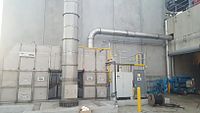
Photo from wikipedia
Abstract Numerical investigations were carried out with special attentions on the inlet and outlet behaviors of foam flow process in a homogeneous porous media with confined entrance and exit boundaries.… Click to show full abstract
Abstract Numerical investigations were carried out with special attentions on the inlet and outlet behaviors of foam flow process in a homogeneous porous media with confined entrance and exit boundaries. The Stochastic Bubble Population (SBP) balance model, which usually involves two parameters of the bubble generation rate Kg and the maximum bubble density n∞ for bubble number prediction, was employed to study the dynamic foam generation and development process in porous media. With introduction the Kfp parameter to take into account the foam phase relative permeability reduction effect, the control equations of the two-phase flow process in a two-dimensional computational domain were solved with the IMPES algorithm and the inlet and outlet behavior of the foam displacement process were scrutinized based on detailed analysis of the bubble density, water phase pressure and water phase saturation distributions in porous medium. Numerical results showed a clear entrance effect of higher water saturation, lower pressure gradient and developing bubble density in the inlet region of the porous media in the transient foam displacement process, whereas the confined exit results in elevating water saturation and decreasing pressure gradient towards the outlet of the core. Parametric studies on Kg, n∞, Kfp and inlet & outlet sizes D indicate higher bubble generation rate could remarkably suppress the entrance region in the foam seepage process, while the higher maximum bubble number did not lead to obvious change of the foam flow behavior in the inlet and outlet region, although it could produce higher absolute values of bubble density and pressure drop along the core. With lower Kfp values, the strong foam flooding behavior could be properly predicted with much higher pressure drop and lower water saturation. Two dimensional numerical results at various inlet and outlet sizes clearly show the confined geometry effect on foam flow characteristics with smaller sizes corresponding to longer inlet and outlet regions. Computational domain and numerical results were validated through comparisons with corresponding experimental setup and CT measurement results. It is observed that, the numerical simulation could reproduce not only qualitatively but also quantitatively the experimentally obtained water saturation distribution and pressure drop result. It is concluded that the mechanistic stochastic bubble population model could be reasonably employed on prediction of the inlet and outlet behavior in the transient foam flow process in the homogeneous porous media.
Journal Title: Journal of Petroleum Science and Engineering
Year Published: 2019
Link to full text (if available)
Share on Social Media: Sign Up to like & get
recommendations!